For convenience to astronomers, the International Astronomical Union (IAU) divides the sky into 88 separate areas called constellations, which were defined officially in 1922. These are regions of the celestial sphere, of varying size and shape, surrounding groups of stars in traditionally identified patterns. Many of these are based on the patterns identified in the ancient Greek, Roman and Sumerian cultures, representing creatures, characters and objects from their mythologies.
Note that these patterns of stars are properly referred to by astronomers as asterisms, since the term constellation refers to an area of the sky rather than just the stars within it. There are, of course, many more constellations and asterisms recognised by difference cultures all over the world, however, they are not officially defined as constellations by the IAU.
Many well-recognised asterisms are often identified from just a few of the stars in a particular constellation or even across multiple constellations. Examples include The Big Dipper, also known as The Plough (composed of the seven brightest stars in Ursa Major); the three distinctive stars of Orient’s Belt; and The Summer Triangle formed of the stars Deneb, Altair, and Vega, in the constellations of Cygnus, Aquila, and Lyra, respectively.
Forty eight of the official IAU constellations are based on the ancient Greek tradition and were listed in the Almagest – a mathematical and astronomical treatise written by the Egyptian scholar Ptolemy, in the 2nd Century. Twelve of the constellations were created in the 16th Century by Petrus Plancius, a Flemish astronomer, from the observations by the Dutch explorers Pieter Dirkszoon Keyser and Frederick de Houtmanin, at a time when voyagers were first charting the southern skies. The French astronomer Abbé Nicolas Louis de Lacaille introduced 14 more in the 18th century and Johannes Hevelius also created seven of our modern constellations in his star atlas Firmamentum Sobiescianum, published in 1687, from areas of the northern sky without apparent bright patterns of stars.
List of IAU Constellations:
The full list of the 88 official IAU constellations, and their origins, is given below:
-
Andromeda
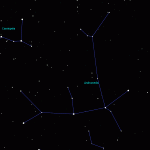
Andromeda – the Princess The Princess – chained to rocks in Greek mythology, as a sacrifice to the sea-monster Cetus and rescued by Perseus.
-
Antlia
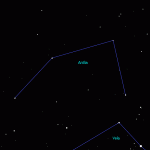
Antlia – the air pump The air pump – defined in 1756 by Nicolas Louis de Lacaille, to commemorate the air pump invented by the French physicist Denis Papin.
-
Apus
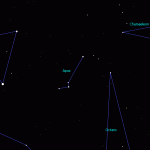
Apus – the bird of paradise The bird of paradise – once believed to have no feet, hence its name meaning “without feet” in Greek.
-
Aquarius
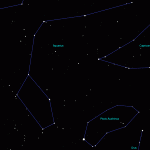
Aquarius – the water carrier The water carrier or cup bearer – an ancient constellation associated with different legends in different cultures. In Greek tradition, the constellation was a vase from which a stream poured down to Piscis Austrinus, the Southern Fish. In Babylonian tradition Aquarius represented the god Ea.
-
Aquila
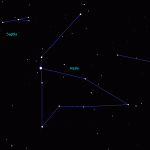
Aquila – the eagle The eagle – which carried Zeus’ thunderbolts in ancient Greek tradition and Jupiter’s in Roman tradition, or alternatively the eagle which retrieved Orpheus’ lyre (see Lyre, below).
-
Ara
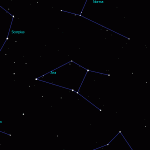
Ara – the Altar The Altar – where the Greek/Roman gods made offerings before defeating the Titans.
-
Aries
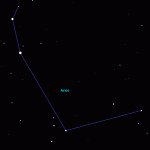
Aries – the ram The Ram – having a golden fleece in the Greek legend, as sought after by Jason and the Argonauts.
-
Auriga
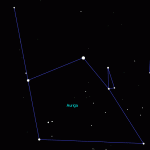
Auriga – the charioteer The charioteer – in Greek mythology, the hero Erichthonius of Athens, the inventor of the four-horse chariot.
-
Boötes
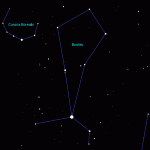
Boötes – The ox-driver The ox-driver, herdsman or plowman – pronounced boh-OH-teez – perhaps represents Philomenus, the herdsman son of Demeter, the inventor of the plough in Greek mythology, which he pushes across the sky (see Ursa Major, below).
-
Caelum
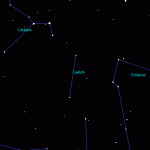
Caelum – the chisel The chisel – (from Latin) introduced by Nicolas Louis de Lacaille in the 1750s.
-
Camelopardalis
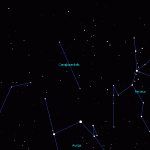
Camelopardalis – the giraffe The giraffe – introduced around 1612 by Petrus Plancius.
-
Cancer
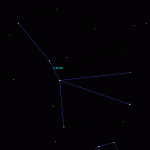
Cancer – the crab The crab, which, in Greek mythology, bit Heracles (Roman: Hercules) on the foot while he was fighting the Hydra. Heracles crushed the crab underfoot and it was placed among the stars by the goddess Hera, his sworn enemy.
-
Canes Venatici
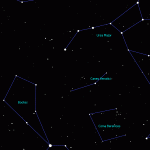
Canes Venatici – the hunting dogs The hunting dogs – of Boötes the herdsman – created by Johannes Hevelius in the 17th century.
-
Canis Major
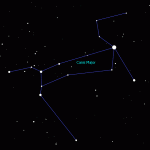
Canis Major – the greater dog The greater dog – of Orion the hunter – contains the brightest star in the sky, Sirius, which is also known as the “Dog Star”.
-
Canis Minor
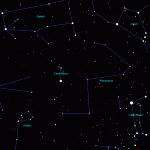
Canis Minor – the lesser dog The lesser dog – of Orion the hunter.
-
Capricornus
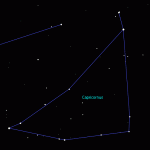
Capricornus – the sea-goat The horned goat or sea-goat (half goat, half fish) – identified since the Middle Bronze Age. One of the earliest depictions or Capricornus was found on a Sumerian cylinder-seal, dating from the 21st century BC.
-
Carina
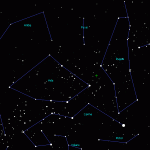
Carina – the ship’s keel (with vela and puppis) The ship’s keel – (from latin) originally part of the constellation of Argo Navis (Jason and the Argonauts’ ship, the Argo, in Greek mythology) before it was split into three by Nicolas Louis de Lacaille, in 1763, to form Carina (the keel), Puppis (the poop deck) and Vela (the sails).
-
Cassiopeia
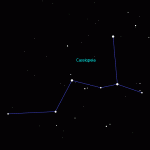
Cassiopeia – queen of Aethiopia The queen of king Cepheus of Aethiopia – in Greek mythology, boasted that she and her daughter Andromeda were more beautiful than the sea-nymphs, the Nereids. As a punishment, Andromeda was to be sacrificed to the sea monster Cetus, before she was saved by Perseus.
-
Centaurus
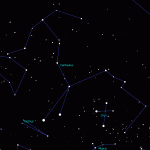
Centaurus – the centaur The centaur – a creature from Greek mythology with the body of a horse and the upper torso and head of a man – possibly the centaur Chiron. Originally, Crux, the Southern Cross, represented the centaur’s legs, before it came to be considered as a separate constellation.
-
Cepheus
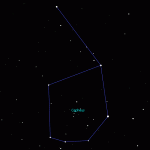
Cepheus – King of Aethiopia The King of Aethiopia – in Greek mythology the husband of Cassiopeia and father of Andromeda.
-
Cetus
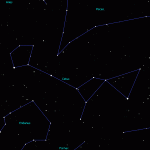
Cetus – the sea-monster or the whale The sea-monster (often known as the whale) – to which princess Andromeda was to be sacrificed in Greek mythology. (N.B. the name Kraken used in the movie Clash of the Titans is actually from Norse mythology.)
-
Chamaeleon
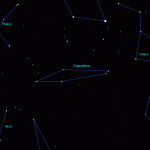
Chamaeleon – the chameleon The chameleon – created by Petrus Plancius in the 16th century.
-
Circinus
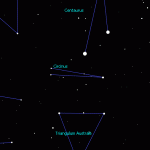
Circinus – the pair of compasses The pair of compasses (N.B the type used for drawing circles, not the mariner’s compass, which is represented by the constellation Pyxis) – first defined by Nicolas Louis de Lacaille, in 1756.
-
Columba
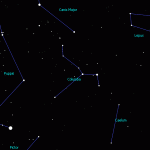
Columba – the dove The dove – representing either the dove released by Noah in the Bible story or the dove released by Jason and the Argonauts – created by Petrus Plancius in 1592 from stars in the larger constellation Canis Major.
-
Coma Berenices
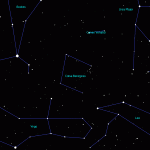
Coma Berenices – Berenice’s hair Berenice’s hair – from Berenice II, an Egyptian queen of the third century who sacrificed her long hair to Aphrodite to ensure her husband’s safe return from Syria. The hair disappeared from the altar and was said to have been placed among the stars. Before this, it was considered to be an asterism representing the tuft of hair on the end of Leo’s tail.
-
Corona Australis
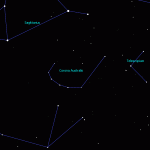
Corona Australis – the southern crown The southern crown – originally the wreath of Sagittarius or Centaurus, rather than a crown, although there are many different stories associated with this constellation.
-
Corona Borealis
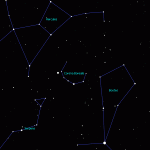
Corona Borealis – the northern crown The northern crown – in Greek mythology, given by Dionysus to Ariadne, and placed among the stars on their wedding day.
-
Corvus
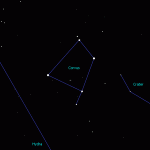
Corvus – the crow The crow – in one Greek myth, Apollo, upon learning from a pure white crow that Coronis had been unfaithful to him, turned the crow’s feathers black, in his anger. Another story tells of a crow that lied to Apollo about stopping to eat figs when sent to fetch water. Apollo threw the crow, the cup (Crater) and the water snake (Hydra) – which the crow claimed had kept him from the water – into the sky, making sure that the cup was just out of reach so that the crow would always be thirsty.
-
Crater
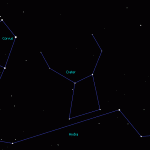
Crater – the cup The cup – of the god Apollo (see Corvus, above).
-
Crux
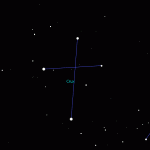
Crux – the southern cross The southern cross – originally considered, by the ancient Greeks, to be the legs of Centaurus. Crux was entirely visible as far north as Britain in the fourth millennium BC but, due to precession of the Earth’s axis, it moved southwards and became invisible from Greece around the 4th Century BC. The constellation was rediscovered by navigators in the 16th century.
-
Cygnus
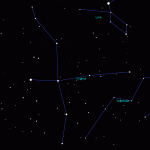
Cygnus – the swan The swan – possibly representing the swan Zeus disguised himself as in order to seduce Leda, although it may represent many other characters from Greek myth, who were turned into swans, such as Orpheus or Cycnus, the brother of Phaethon.
-
Delphinus
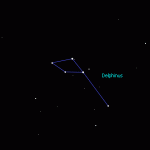
Delphinus – the dolphin The dolphin – possibly representing Delphinus who was sent by Poseidon to woo Amphitrite, or possibly the dolphin that is said to have saved the Greek poet Arion in the 7th century BC.
-
Dorado
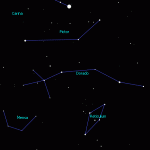
Dorado – the dolphinfish The dolphinfish, or possibly the goldfish – named by Petrus Plancius in the 16th century.
-
Draco
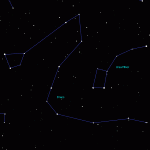
Draco – the dragon The dragon – in Greek mythology the dragon Ladon, who guarded the golden apples of the Hesperides and was killed by Heracles (known as Hercules to the Romans).
-
Equuleus
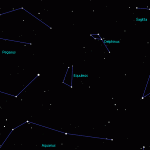
Equuleus – the foal The foal – representing Celeris the foal (or possibly brother of) the winged horse Pegasus, although the constellation might also represent the horse created by Poseidon in his competition with Athena to decide which of the two the city of Athens would be named after.
-
Eridanus
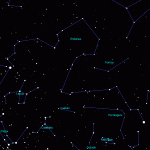
Eridanus – the river The river – has been variously associated with the river Nile, the river Po and, in Greek mythology, the river into which Phaëton is said to have fallen, after losing control of the sun god Helios’ chariot and scorching most of Africa to desert.
-
Fornax
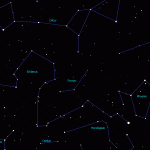
Fornax – the furnace The furnace – originally named “Fornax Chemica”, the chemical furnace used for heating chemical experiments, by Nicolas Louis de Lacaille in 1756.
-
Gemini
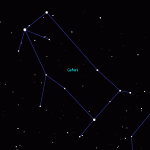
Gemini – the twins The twins – associated with the Argonaut twins Castor and Pollux, which are the names of the constellation’s two brightest stars. In Greek mythology, Castor was mortal but Pollux (which is the brightest of the two stars) was the son of the god Zeus. When Castor died, Pollux asked Zeus to make him immortal, which he did by placing them both among the stars.
-
Grus
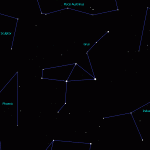
Grus – the crane The Crane – originally considered part of Piscis Austrinus, but were separated out by Petrus Plancius in the 16th Century.
-
Hercules
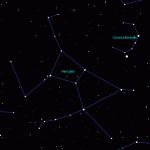
Hercules The Roman hero Hercules (known as Heracles to the ancient Greeks) – supposedly representing him kneeling to pray for help from Jupiter (Greek: Zeus) in his battle with the giants Albion and Bergion or Dercynus.
-
Horologium
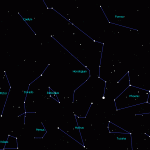
Horologium – the clock The clock – originally named Horologium Oscillitorium, or the pendulum clock, by Nicolas Louis de Lacaille in the early 18th century, to honour its inventor Christiaan Huygens.
-
Hydra
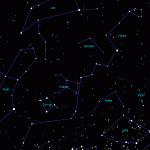
Hydra – the water snake The water snake – not to be confused with Hydrus (below). In Greek mythology, Hydra was considered to represent either the many-headed water snake killed by Heracles (Roman: Hercules) or the water snake in the story of Apollo and the crow (see Corvus, above).
-
Hydrus
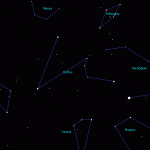
Hydrus – the male water snake The male water snake – not to be confused with Hydra (above) which represents a mythical female water snake. Hydrus was created by Petrus Plancius in the 16th century and represents a real water snake encountered on the first Dutch trading expedition to the East Indies by the explorers Pieter Dirkszoon Keyser and Frederick de Houtman.
-
Indus
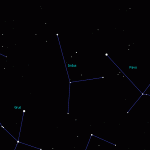
Indus – the Indian The Indian – usually depicted hunting with arrows or a spear. In the 16th century, when the constellation was created by Petrus Plancius, “Indus” could have referred to a native of either America or Asia.
-
Lacerta
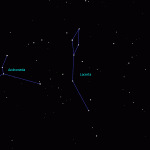
Lacerta – the Lizard The Lizard – created in 1687 by the astronomer Johannes Hevelius in a region of the northern sky without an apparent pattern of bright stars.
-
Leo
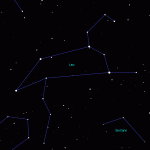
Leo – the lion The lion – represented the Nemean Lion killed by Heracles (Roman: Hercules) in ancient Greek mythology.
-
Leo Minor
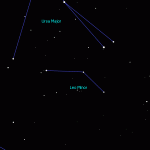
Leo Minor – the lesser lion The lesser lion – created in 1687 by the astronomer Johannes Hevelius in a region of the northern sky without an apparent pattern of bright stars.
-
Lepus
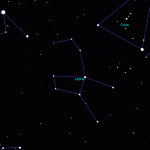
Lepus – the hare The hare – chased by Orion and his hunting dogs, Canis Major and Canis Minor, across the sky.
-
Libra
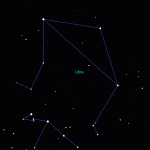
Libra – the weighing scales The weighing scales – the balance held by Astraea (or Virgo), the goddess of justice in Greek mythology. The sun is in this part of the ecliptic plane close to the autumnal equinox, when the length of day and night is in balance.
-
Lupus
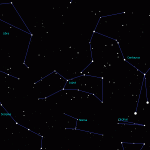
Lupus – the wolf The wolf – about to be killed by Centaurus, the Centaur, and probably based on a Babylonian creature which was half man, half lion.
-
Lynx
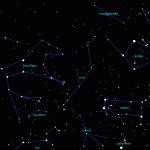
Lynx – the lynx The lynx – created in 1687 by the astronomer Johannes Hevelius in a region of the northern sky without an apparent pattern of bright stars.
-
Lyra
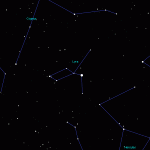
Lyre the lyra – a musical instrument belonging to the Greek hero Orpheus and thrown into a river when he was killed. Zeus sent an eagle (see Aquila) to retrieve the lyre and both were placed among the stars.
-
Mensa
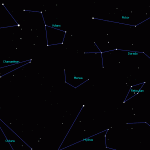
Mensa – Table Mountain Table Mountain – created by Nicolas Louis de Lacaille in the 18th century, in honour of Table Mountain in South Africa. Mensa is the fainest of all the constellations, as well as the only one representing a geographical feature on Earth.
-
Microscopium
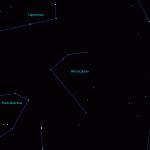
Microscopium – the microscope The microscope – created by Nicolas Louis de Lacaille in the 18th century.
-
Monoceros
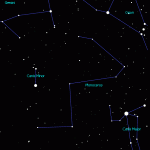
Monoceros – the unicorn The unicorn – created by Petrus Plancius in 1612.
-
Musca
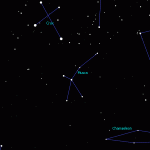
Musca – the fly The fly – created by Petrus Plancius in the 16th century.
-
Norma
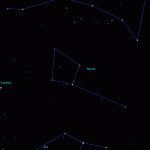
Norma – the carpenter’s level The carpenter’s level – created by Nicolas Louis de Lacaille in the 18th century.
-
Octans
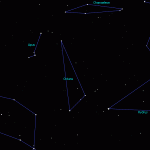
Octans – the octant The octant – created by Nicolas Louis de Lacaille in the 18th century and named after the navigational instrument used to determine the altitude of celestial objects relative to the horizon (see also Sextans, below).
-
Ophiuchus
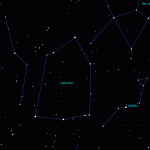
Ophiuchus – the serpent bearer The serpent bearer – representing, to the ancient Greeks, either the god Apollo, with the snake that guarded the Oracle of Delphi, or Laocoön, the Trojan priest of Poseidon, who warned not to trust the wooden horse of Troy and was killed by sea serpents sent to punish him. To the Romans, he represented Asclepius, who learned the secret of immortality after observing a serpent using healing herbs, but was struck down by Jupiter before he could share the secret.
-
Orion
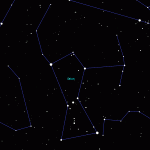
Orion – the hunter The hunter – in Greek mythology, Orion claimed he could kill any animal but was stung by a scorpion (Scorpius, see below) sent by the Earth goddess Gaia (or possibly Artemis or Apollo). Orion was then revived by Asclepius (Ophiuchus, see above). Orion is one of the most distinctive constellations and is, therefore, associated with numerous legends from all over the world, notably representing the god Osiris in the ancient Egyptian culture and Gilgamesh in Mesopotamian tradition.
-
Pavo
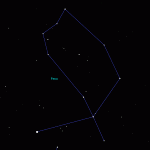
Pavo – the peacock The peacock – defined by Petrus Plancius in the 16th century, although the constellation might also have represented Argos, to the ancient Greeks – the hundred-eyed giant whose eyes were placed by the goddess Hera in the tail of a peacock.
-
Pegasus
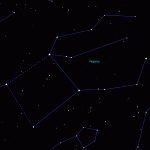
Pegasus – the winged horse The winged horse – ridden by Bellerophon and Perseus in ancient Greek mythology. Pegasus contains a large distinctive square, containing few stars, known as “The Great Square of Pegasus”, although one of its corner stars (α Andromedae) is now recognised as part of Andromeda.
-
Perseus
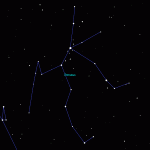
Perseus The hero from ancient Greek mythology – who rescued the princess Andromeda from Cetus (see above).
-
Phoenix
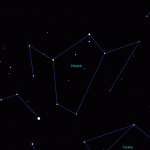
Phoenix The phoenix – a mythical bird which is resurrected from its own ashes. The constellation Phoenix was created by Nicolas Louis de Lacaille in the 18th century.
-
Pictor
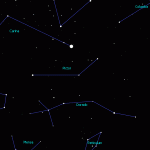
Pictor – the painter’s easel The painter’s easel – created by Nicolas Louis de Lacaille in the 18th century.
-
Pisces
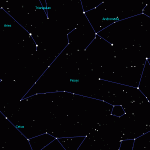
Pisces – the fishes The fishes – in Greek mythology, represents the goddess Aphrodite and the god Eros, who transformed themselves into fish to escape from the monster Typhon. They tied themselves together with rope so they wouldn’t become separated. Alternatively, they may represent the offspring of the Piscis Austrinus (see below).
-
Piscis Austrinus
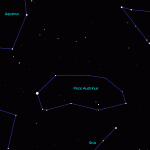
Piscis Austrinus – the southern fish The southern fish – swallows the stream of water poured from the vase of the constellation Aquarius. Piscis Austrinus is possibly the mother of the two smaller fish Pisces and also represented a fish in Babylonian as well as Egyptian culture, where it depicted the fish which saved the life of the Egyptian goddess Isis.
-
Puppis
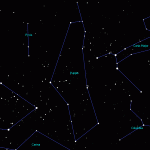
Puppis – the Poop Deck The Poop Deck – (from latin) originally part of the constellation of Argo Navis (Jason and the Argonauts’ ship, the Argo, in Greek mythology) before it was split into three by Nicolas Louis de Lacaille, in 1763, to form Carina (the keel), Puppis (the poop deck) and Vela (the sails).
-
Pyxis
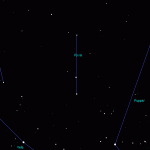
Pyxis – the mariner’s compass The mariner’s compass – (N.B not the type used for drawing circles, which is represented by the constellation Circinus) – first defined by Nicolas Louis de Lacaille, in 1756.
-
Reticulum
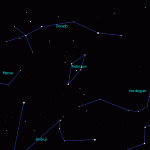
Reticulum – the reticle The reticle or graticule – the ‘net’ of crosshairs in a telescope’s eyepiece. Nicolas Louis de Lacaille first named the constellation le Réticule Rhomboide, in the eighteenth century.
-
Sagitta
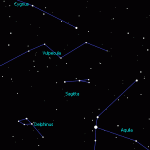
Sagitta – the arrow The arrow – In ancient Greek mythology, represented the arrow used by Hercules (Greek: Heracles) to kill either the eagle that, each day, picked out the liver of Prometheus (as his punishment for stealing fire from the gods) or the Stymphalian birds, which Hercules killed as the sixth of his “twelve labours”. Alternatively it may even represent the arrow used by Apollo to kill the Cyclopes.
-
Sagittarius
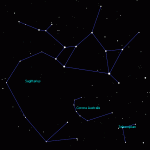
Sagittarius – the archer The archer – to the Babylonians, the god Nergal, to the ancient Greeks, the centaur Chiron or possibly the satyr Crotus, the inventor of archery, since Centaurus (see above) may represent Chiron. The brightest stars of Sagittarius form a distinctive teapot shaped asterism, with the Milky Way appearing to rise as steam from the spout.
-
Scorpius
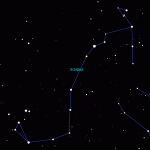
Scorpius – the scorpion The scorpion – sent by either Gaia, Artemis or Apollo to sting Orion, after he boasted he would kill every animal (see also Orion, above).
-
Sculptor
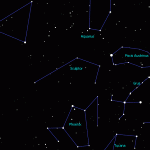
Sculptor – the sculptor the sculptor – originally the sculptor’s studio – created by Nicolas Louis de Lacaille in the 18th century.
-
Scutum
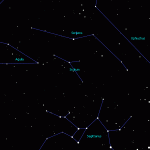
Scutum – the shield The shield – created in 1684 by Johannes Hevelius, and originally named Scutum Sobiescianum (the shield of Sobieski), commemorating the Polish victory of King John III Sobieski in the Battle of Vienna (1683).
-
Serpens
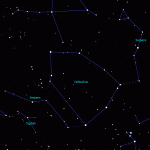
Serpens – the serpent The serpent – held by Ophiuchus (see above).
-
Sextans
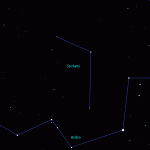
Sextans – the sextant The sextant – created by Johannes Hevelius in the 1687 and named after the instrument used by astronomers and navigators to determine the altitude of celestial objects relative to the horizon (See also, Octans).
-
Taurus
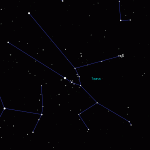
Taurus – the bull The bull – possibly represented in a cave painting, from around 15,000 BC, at the Hall of the Bulls in the caves at Lascaux, in France. In the Mesopotamian legend of Gilgamesh (represented by Orion), the spurned goddess Ishtar sends Taurus, the Bull of Heaven, to kill him. To the ancient Greeks, Taurus depicted either the god Zeus, in the form of a white bull while abducting the princess Europa, or the Cretan Bull, killed by Heracles (Roman: Hercules). The distinctive orange giant star, Aldebaran, forms the bull’s eye.
-
Telescopium
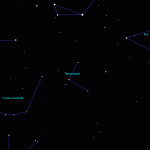
Telescopium – the telescope The telescope – created by Nicolas Louis de Lacaille in the 18th century.
-
Triangulum
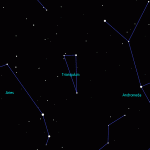
Triangulum – the triangle The triangle – Possibly represented the Nile Delta to the Greeks (resembling also the Greek letter delta) or the island of Sicily to the Romans.
-
Triangulum Australe
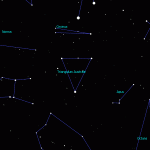
Triangulum Australe – the southern triangle The southern triangle – Petrus Plancius introduced this constellation in the 16th century, although his placement was inaccurate, and he called it Triangulus Antarcticus. It was first depicted accurately and called Triangulum Australe in Johann Bayer’s atlas, Uranometria, of 1603.
-
Tucana
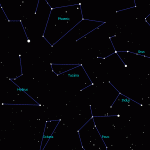
Tucana – the toucan The toucan – introduced by Petrus Plancius in the 16th century.
-
Ursa Major
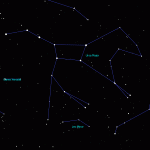
Ursa Major – the Great Bear (also known as the big dipper, the saucepan or the Plough) The great bear – represents Callisto, in Roman and Greek mythology, who was turned into a bear by Jupiter’s (Greek: Zeus’) jealous wife, Juno (Greek: Hera). In the legend, Callisto’s son, Arcas, almost shoots her while hunting, but Jupiter turns him into a bear as well (Ursa Minor) and places them both among the stars. Ursa Major contains the asterism resembling a saucepan or ladle, giving it the name “The Big Dipper”. It is also known as “The Plough”, pushed across the sky by Boötes (see above), as well as many other names.
-
Ursa Minor
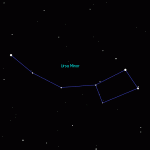
Ursa Minor – the little bear The little bear – in Greek and Roman mythology, represented Callisto’s son Arcas (see Ursa Major above). However, in early Greek mythology, Ursa Minor’s seven stars were the Hesperides, daughters of Hesperus, the evening star (although sometimes considered to be the daughters of Atlas). Also known as the “Little Dipper”.
-
Vela
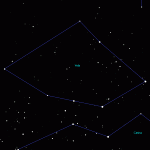
Vela – the ship’s sails The ship’s sails – (from latin) originally part of the constellation of Argo Navis (Jason and the Argonauts’ ship, the Argo, in Greek mythology) before it was split into three by Nicolas Louis de Lacaille, in 1763, to form Carina (the keel), Puppis (the poop deck) and Vela (the sails).
-
Virgo
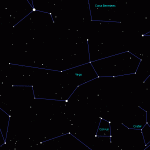
Virgo – the virgin The virgin – represented Demeter or Ceres in Greek and Romans mythology, respectively, (the goddess of agriculture) or the goddess Iustitia or Astraea, holding Libra, the scales of justice. The name of Virgo’s brightest star Spica means “ear of grain” in Latin, reflecting the Babylonian association of Virgo as “The Furrow”.
-
Volans
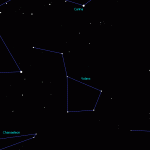
Volans – the flying fish The flying fish – originally Piscis Volans, created by Petrus Plancius in the 16th century.
-
Vulpecula
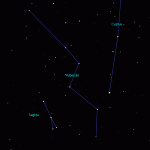
Vulpecula – the little fox The little fox – created by Johannes Hevelius in the 17th century as “Vulpecula Cum Ansere” (the little fox with the goose). The goose, Anser, is now the name of one the constellation’s stars.